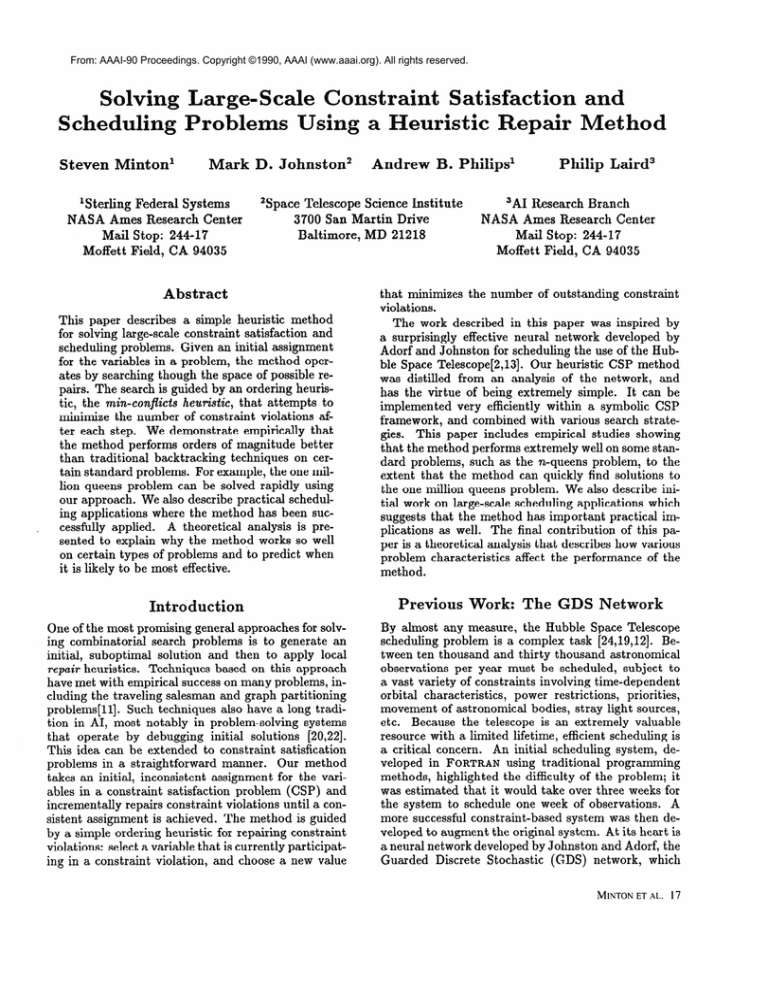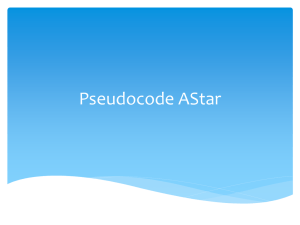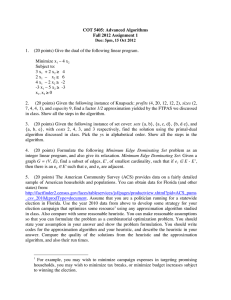
From: AAAI-90 Proceedings. Copyright ©1990, AAAI (www.aaai.org). All rights reserved.
Stolving Large-Scale Constraint
Scheduling Problems Using a
Steven Mintonl
Mark
lsterling Federal Systems
NASA Ames Research Center
Mail Stop: 244-17
MofFett Field, CA 94035
D. Johnston2
B. Philips1
2Spac~7ede~~~~~~~~~c~~~~~titute
.
Baltimore,
Abstract
.
Andrew
Satisfaction an
epair Metho
This paper describes a simple heuristic method
for solving large-scale constraint satisfaction and
scheduling problems. Given an initial assignment
for the variables in a problem, the method operates by searching though the space of possible repairs. The search is guided by an ordering heuristic, the min-conflicts
heuristic, that attempts to
minimize the number of constraint violations after each step. We demonstrate empirically that
the method performs orders of magnitude better
than traditional backtracking techniques on certain standard problems. For example, the one million queens problem can be solved rapidly using
our approach. We also describe practical scheduling applications where the method has been successfully applied. A theoretical analysis is presented to explain why the method works so well
on certain types of problems and to predict when
it is likely to be most effective.
Introduction
One of the most promising general approaches for solving combinatorial search problems is to generate an
initial, suboptimal solution and then to apply local
repair heuristics. Techniques based on this approach
have met with empirical success on many problems, including the traveling salesman and graph partitioning
problems[ll]. Such techniques also have a long tradition in AI, most notably in problem-solving systems
that operate by debugging initial solutions [20,22].
This idea can be extended to constraint satisfication
problems in a straightforward manner. Our method
takes an initial, inconsistent assignment for the variables in a constraint satisfaction problem (CSP) and
incrementally repairs constraint violations until a consistent assignment is achieved. The method is guided
by a simple ordering heuristic for repairing constraint
violations: select a variable that is currently participating in a constraint violation, and choose a new value
MD 21218
Philip Laird3
3AI Research Branch
NASA Ames Research Center
Mail Stop: 244-17
Moffett Field, CA 94035
that minimizes the number of outstanding constraint
violat ions.
The work described in this paper was inspired by
a surprisingly effective neural network developed by
Adorf and Johnston for scheduling the use of the Hubble Space Telescope[2,13]. Our heuristic CSP method
was distilled from an analysis of the network, and
has the virtue of being extremely simple. It can be
implemented very efficiently within a symbolic CSP
framework, and combined with various search strategies. This paper includes empirical studies showing
that the method performs extremely well on some standard problems, such as the n-queens problem, to the
extent that the method can quickly find solutions to
the one million queens problem. We also describe initial work on large-scale scheduling applications which
suggests that the method has important practical implications as well. The final contribution of this paper is a theoretical analysis that describes how various
problem characteristics affect the performance of the
method.
Previous
Work:
The GDS
Network
By almost any measure, the Hubble Space Telescope
scheduling problem is a complex task [24,19,12]. Between ten thousand and thirty thousand astronomical
observations per year must be scheduled, subject to
a vast variety of constraints involving time-dependent
orbital characteristics, power restrictions, priorities,
movement of astronomical bodies, stray light sources,
etc. Because the telescope is an extremely valuable
resource with a limited lifetime, efficient scheduling is
a critical concern. An initial scheduling system, developed in FORTRAN using traditional programming
methods, highlighted the difficulty of the problem; it
was estimated that it would take over three weeks for
the system to schedule one week of observations. A
more successful constraint-based system was then developed to augment the original system. At its heart is
a neural network developed by Johnston and Adorf, the
Guarded Discrete Stochastic (GDS) network, which
MINTON ET AL.
17
searches for a schedule [2,13].
From a computational point of view, the network
is interesting because Johnston and Adorf found that
it performs well on a variety of tasks, in addition to
the space telescope scheduling problem.
For example, the network performs significantly better on the nqueens problem than previous heuristic methods. The
n-queens problem requires placing n queens on an n x n
chessboard so that no two queens share a row, column or diagonal. The network has been used to solve
problems of up to 1024 queens, whereas previous methods discussed in the literature[21] encounter difficulties
with problems that are ten times smaller. Later in this
paper we describe how our analysis of the GDS network
enabled us to build a simple heuristic algorithm that
performs even better.
The GDS network is a modified Hopfield network[9].
The most significant modification is that the main network is coupled asymmetrically to an auxiliary network
of guard neuTons which restricts the configurations that
the network can assume. This modification enables
the network to rapidly find a solution for many problems, even when the network is simulated on a serial
machine. The disadvantage is that convergence to a
stable configuration is no longer guaranteed. Thus,
the network can fall into a local minimum involving a
group of unstable states among which it will oscillate.
In practice, however, if the network fails to converge
after some number of neuron state transitions, it can
simply be stopped and started over. ’
To illustrate the network architecture and updating scheme, let us consider how the network is used
to solve binary constraint satisfaction problems. A
problem consists of n variables, Xr . . . Xn, with domains Dr . . . D,, and a set of binary constraints. Each
constraint Ca(Xj, Xk) is a subset of Dj x Dk specifying incompatible values for a pair of variables.2 To
solve a CSP using the network, each variable is represented by a separate set of neurons, one neuron for
each of the variable’s possible values. Each neuron is
either “on” or “off”, and in a solution state, every variable will have exactly one of its corresponding neurons
“on” , representing the value of that variable. Constraints are represented by inhibitory (i.e., negatively
weighted) connections between the neurons. To insure
that every variable is assigned a value, there is a guard
neuron for each set of neurons representing a variable;
if no neuron in the set is on, the guard neuron will provide an excitatory input that is large enough to turn
‘The emphasis in Johnston and Adorf’s work is to produce a computational
architecture that can efficiently solve
CSP problems, as opposed to modeling cognitive or neural
behavior. Our discussion necessarily ignores many aspects
of Johnston and Adorf’s work, which is described in detail
elsewhere[l3,2].
2This paper on 1y considers the task of finding a single
solution, that is, finding an assignment for each of the variables which satisfies the constraints.
18 AUTOMATEDREASONING
one on. (Due to the way the connection weights are
set up, it is unlikely that the guard neuron will turn
on more than one neuron.) The network is updated on
each cycle by randomly picking a set of neurons that
represents a variable, and flipping the state of the neuron in that set whose input is most inconsistent with
its current output (if any). When all neurons’ states
are consistent with their input, a solution is achieved.
The Min-Conflicts
Heuristic
Why does the GDS network perform so much better
than traditional backtracking methods on tasks such
as the n-queens ? In addressing this question, we began with a number of competing hypotheses (some of
which were suggested by Adorf and Johnston[2]). For
instance, one hypothesis was that the systematic nature of the search carried out by backtracking is the
source of its problems, as compared to the stochastic
nature of the search carried out by the network. Specifically, if solutions in the backtracking space are clustered together (with correspondingly high inter-cluster
distances), then a completely randomized search of the
space can be more effective than systematic backtracking. However, although tasks such as n-queens are
in fact solved more efficiently using randomized algorithms (such as Las Vegas algorithms [4]), our studies
indicate that the performance of the GDS network is
far too good to be explained by this hypothesis.
As it turns out, the key to the network’s performance
appears to be that when it chooses a neuron to update,
it chooses the neuron whose state is most inconsistent
with its input. Thus, from a constraint satisfaction
perspective, the network will “deassign” a variable’s
current value only if it is inconsistent with other variables. Furthermore, when a new value is later assigned,
the network will choose the value that minimizes the
number of other variables that it is inconsistent with.
This idea is captured by the following heuristic:
Min-Conflicts heuristic:
Given: A set of variables, a set of binary constraints,
and an assignment specifying
a value for each variable. Two variables co@ict
if their values violate a
constraint.
Procedure;
Select a variable that is in conflict, and assign it a value that minimizes the number of conflicts.3
(Break ties randomly.)
We have found that the network’s behavior can be
approximated by a symbolic system that uses the min31n general, the heuristic attempts to minimize the number of other variables that will need to be repaired.
For
binary CSPs, this corresponds to minimizing
the number
For general CSPs, where a single
of conflicting variables.
constraint may involve several variables, the exact method
of counting the number of variables that will need to be repaired depends on the particular
constraint.
The space
telescope scheduling problem is a general CSP, whereas
most of the other tasks described in this paper are binary
CSPS.
conflicts heuristic for hill-climbing. The hill-climbing
system starts with an initial assignment generated in a
preprocessing phase. At each choice point, the heuristic chooses a variable that is currently in conflict and
reassigns its value, until a solution is found. The system thus searches the space of possible assignments,
favoring assignments with fewer total conflicts.
Of
course, the hill-climbing system can become “stuck”
in a local maximum, in the same way that the network
may become “stuck” in a local minimum. In the next
section we present empirical evidence to support our
claim that the min-conflicts heuristic is responsible for
the network’s effectiveness.
One of the virtues of extracting the heuristic from
the network is that the heuristic can be used with a
variety of different search strategies in addition to hillclimbing. For example, we have found that informed
backtracking can be an effective strategy when used in
the following manner. Given an initial assignment generated in a preprocessing phase (as described above),
an informed backtracking program employs the minconflicts heuristic to order the choice of variables and
values to consider, as described in figure 1. Initially
the variables are all on a list of VARS-LEFT, and as
they are repaired, they are pushed onto a list of VARSDONE. The program attempts to find a sequence of
repairs, such that no variable is repaired more than
once. If there is no way to repair a variable in VARSLEFT without violating a previously repaired variable
(a variable in VARS-DONE), the program backtracks.
It should be clear that the informed backtracking algorithm is simply a basic backtracking algorithm augmented with the min-conflicts heuristic to order its
choice of which variable and value to attend to. This illustrates an important point. The informed backtracking program incrementally extends a consistent partial
assignment (i.e., VARS-DONE), in the same manner as
a basic backtracking program, but in addition, uses information from the initial assignment (i.e., VARS-LEFT)
to bias its search. The next section documents the degree to which this information is useful.
Experimental
Results
This section has two purposes.
First, we evaluate
the performance of the min-conflicts heuristic on some
standard tasks using a variety of search strategies. Second, we show that the heuristic, when used with a hillclimbing strategy, approximates the behavior of the
GDS network.
We have employed the following search strategies
with the min-conflicts heuristic:
1. Hill-climbing: This strategy most closely replicates
the behavior of the GDS network. The disadvantage
is that a hill-climbing program can get caught in
local maxima, in which case it will not terminate.
2. Informed backtracking: As described earlier, this
strategy is a basic backtracking strategy, augmented
ProcedureINFORMED-BACKTRACK
WARS-LEFT VARS-DONE)
If all variablesare consistent,
then solutionfound, STOP.
Let VAR = a variable in VARS-LEFT
that is in conflict.
Remove VAR from VARS-LEFT.
Push VAR onto VARS-DONE.
Let VALUES = list of possiblevalues for VAR
ordered in ascendingorder accordingto number
of conflictswith variablesin VARS-LEFT.
For each VALUE in VALUES,until solutionfound:
If VALUE does not conflictwith any variable
that is in VARS-DONE,then
Assign VALUE to VAR.
Call INFORMED-BACKTRACKCVARS-LEFT
VARS-DONE)
end if
end for
end procedure
Begin program
Let VARS-LEFT= list of all variables,
each assignedan initial value.
Let VARS-DONE= nil
Call INFORMED-BACKTRACKWARS-LEFT
VARS-DONE)
End program
Figure 1: Informed
Conflicts Heuristic
Backtracking
Using the Min-
with the min-conflicts heuristic for ordering the assignment of variables and values. Because the minconflicts heuristic repairs the initial assignment, it
can also be viewed as backtracking in the space of
possible repairs. One advantage of this strategy is
that it is complete-if there is a solution, it will eventually be found; if not, failure will be reported. Unfortunately, this is of limited significance for largescale problems because terminating in a failure can
take a very long time. A second advantage is that
the strategy can be augmented with pruning heuristics which cut off unpromising branches. This can
be very useful, as documented in the next section.
3. Best-first search: This strategy keeps track of multiple assignments (each corresponding to a leaf in the
search tree). On each cycle it picks the assignment
with the fewest constraint violations and considers
the set of repairs that can be applied to that assignment. We have found that best-first search (of
which A* is one variation) is generally expensive to
employ on large-scale problems due to the cost of
maintaining multiple assignments.
The N-Queens
Problem
The n-queens problem, originally posed in the 19th
century, has become a standard benchmark for testing backtracking and CSP algorithms. In a sense, the
problem of finding a single solution was “solved” in the
1950’s by the discovery of a pair of patterns that can
MINTON ET AL. 19
Strategy
n=lO1
Basic Backtracki
Most Constrained Backtrackt
53.8
17.4
n = lo2
n=103
n=104
n=105
n=
lo6
4473 (70%)
687 (96%)
88650(13%)
22150 (81%)
*
*
*
*
*
*
MinConflicts Hi-Climbingx
57.0
55.6
48.8
48.5
52.8
48.3
MinConflicts Backtrackt:
46.8
25.0
30.7
27.5
27.8
26.4
i = number of backtracks,
* = exceeded computational
$ = number of repairs
resources (100 runs required > 12 hours on a SPARCstationl)
Table 1: Number of Backtracks/Repairs
be instantiated in linear time to yield a solution[l].
Nevertheless, the problem has remained relatively
“hard” for heuristic search methods.
Several studies of the n-queens problem [21,8,14] have compared
heuristic backtracking methods such as search rearrangement backtracking (e.g., most-constrained first),
forward checking, dependency-directed backtracking,
etc. However, no previously identified heuristic search
method has been able to consistently solve problems
involving hundreds of queens within a reasonable time
limit.
On the n-queens ,problem, Adorf and Johnston [2]
reported that the probability of the GDS network converging increases with the size of the problem. For
large problems, e.g., n > 100 (where n is the number of queens), the network almost certainly converges.
Moreover, the median number of cycles required for
convergence is only about 1.167~. Since it takes O(n)
time to execute a transition (i.e., picking a neuron and
updating its connections), the expected time to solve
a problem is (empirically) approximately O(n2). The
network has been used to solve problems with as many
as 1024 queens, which takes approximately 11 minutes
in Lisp on a TI Explorer II. For larger problems, memory becomes a limiting factor because the the network
requires approximately O(n2) space. (Although the
number of non-zero connections is O(n3), some connections are computed dynamically rather than stored).
To compare the network with our min-conflicts approach, we constructed a hill-climbing program that
operates as follows. An initial assignment is created
in a preprocessing phase using a greedy algorithm that
iterates through the rows, placing each queen on the
column where it conflicts with the fewest previously
placed queens (breaking ties randomly). In the subsequent repair phase, the program keeps repairing the
assignment until a solution is found. To make a repair, the program selects a queen that is in conflict and
moves it to a different column in the same row where
it conflicts with the fewest other queens (breaking ties
randomly). Interestingly, we found that this program
performs significantly better than the network. For
n 2 100 the program has never failed to find a solution.
Moreover, the required number of repairs appears to
remain constant as n increases. After further analysis,
however, we found the hill-climbing program performs
20 AUTOMATEDREASONING
for N-Queens Algorithms
better than the network because the hill-climbing program’s preprocessing phase invariably produces an initial assignment that is “close” to a solution, in that
the number of conflicting queens in the initial assignment grows extremely slowly (from a mean of 3.1 for
n = 10 to a mean of 12.8 for n = 10”). Once this difference was eliminated, by starting the network in an
initial state produced by our preprocessing algorithm,
the network and the hill-climbing program performed
quite similarly. We note, however, that the network
requires O(n2) space, as compared to the O(n) space
required by the hill-climbing program, which prevented
us from running very large problems on the network.
Table 1 compares the efficiency of our hill-climbing
program and several backtracking programs. Each program was run 100 times for n increasing from 10 to
one million. Each entry in the table shows the mean
number of queens moved, where each move is either
a backtrack or a repair, depending on the program.
A bound of n x 100 queen movements was employed
so that the experiments could be conducted in a reasonable amount of time; If the program did not find a
solution after moving n x 100 queens, it was terminated
and credited with n x 100 queen movements. For the
cases when this occurred, the corresponding table entry indicates in parentheses the percentage of times
the program completed successfully.
The first row
shows the results for a basic backtracking program. For
n 2 1000, the program was completely swamped. The
second row in the table shows the results for informed
backtracking using the “most-constrained first” heuristic. This program is a basic backtracking program that
selects the row that is most constrained when choosing
the next row on which to place a queen. In an empirical
study of the n-queens problem, Stone and Stone [21]
found that this was by far the most powerful heuristic for the n-queens problem out of several described
earlier by Bitner and Reingold[3]. The program exhibited highly variable behavior. At n = 1000, the
program found a solution on only 81% of the runs, but
three-quarters of these successful runs required fewer
than 100 backtracks. Unfortunately, for n > 1000,
one hundred runs of the program required considerably
more than 12 hours on a SPARCstationl, both because
the mean number of backtracks grows rapidly and because the “most-constrained first” heuristic takes O(n)
Problem Size
Figure 2: Mean Solution Time for Hill-Climbing Pro
gram on N-Queens Problem
time to select the next row after each backtrack. Thus
we were prevented from generating sufficient data for
n > 1000. The next row in the table shows the results for hill-climbing using the min-conflicts heuristic. As discussed above, this algorithm performed extremely well, requiring only about 50 repairs regardless
of problem size. The final row shows the results for
an informed backtracking program that used the minconflicts heuristic as described in the previous section.
We augmented this program with a pruning heuristic
that would initiate backtracking when the number of
constraint violations along a path began to increase significantly. However, for n > 100, this program never
backtracked (i.e., no queen had to be repaired more
than once). The results are better than those for the
hill-climbing program (although there is little room for
improvement) primarily because the hill-climbing program tends to repair the same queen again and again.
We note that for the two programs using the minconflicts heuristic, each repair requires O(n) time in
the worst case. However, this is a relatively minor
price to pay. Since the number of repairs remains approximately constant as n grows, the average runtime
of the program is approximately linear. This is illustrated by figure 2, which shows the average runtime for
the hill-climbing program. In terms of realtime performance, this program solves the million queens problem
in less than four minutes on a SPARCstationl.
(The
algorithm can also be optimized for large problems, in
which case the solution time is less than a minute and
a half.)
Scheduling
Applications
A scheduling problem involves placing a set of tasks
on
a time
line,
subject
to
temporal
constraints,
re-
source constraints, preferences, etc. The space telescope scheduling problem, as discussed earlier, is a
complex problem on which traditional backtracking
and operations research techniques perform poorly.
The problem can be considered a constraint optimization problem where we must maximize both the number and the importance of the constraints that are satisfied. In practice, the GDS network has performed
quite well using a relatively simple approach.
The
network, in effect, attempts to satisfy as many “important” constraints as possible; less “important” constraints, or preferences, are used to break ties during
the update procedure. Naturally, a similar approach
can be used with the min-conflicts heuristic. As usual,
we minimize the number of conflicts, but rather than
breaking ties randomly, the preference constraints are
used to break ties. (Due to space limitations, we only
report our main results here. See [18] for a more indepth discussion of this application.)
The min-conflicts heuristic under hill-climbing has
been shown to be at least as effective as the GDS
network on representative data sets provided by the
Space Telescope Sciences Institute. Moreover, because
the min-conflicts heuristic is so simple, the scheduling
program was easy to code and is extremely efficient.4
While this may be regarded as just an implementation
issue, we believe that the clear and simple formulation
of the method was a significant enabling factor. We
are currently experimenting with a variety of different search strategies that can be combined with the
min-conflicts heuristic. Although this study is not yet
complete, we expect that the improvements in speed
we have observed will eventually translate into better
schedules, since the search process can explore a larger
number of acceptable schedules.
The min-conflicts method has also been tested on
data on the Space Shuttle Payload Scheduling problem, another complex, real-world scheduling problem.
Preliminary results show that the method performs far
better than a backtracking CSP program that was previously built for this task[26]. Additional corroboration comes from a parallel study by Zweben[25], who
has investigated a related method for repairing schedules using simulated annealing. In general, it appears
that repair-based methods fare quite well on this problem. An additional bonus, as Zweben has pointed out,
is that repair-based methods can also be used for dynamic rescheduling. In many domains this capability
is important because unexpected events may require
frequent schedule revision.
Other
Applications
The min-conflicts and/or GDS network have also been
tried on a variety of other problems with good (but
4The scheduling program runs at least an order of magnitude faster than the network, although some of the improvement is due to factors such as programming
language
differences. This makes a precise comparison difficult.
MINTONETAL.
21
preliminary) results, including the randomly generated
problems described by Dechter and Pearl [6,2] and conjunctive precondition matching problems[l7]. We are
currently cataloging the types of applications for which
our method works well.
We have also compared the performance of the GDS
network and the mm-conflicts heuristic on graph 3colorability, a well-studied NP-complete problem. In
this problem, we are given an undirected graph‘with n
vertices. Each vertex must be assigned one of three colors subject to the constraint that no neighboring vertices be assigned the same color. Adorf and Johnston
found that the performance of the network depended
greatly on the connectivity of the graph. On sparsely
connected graphs (with average vertex degree 4) the
network performed poorly, becoming caught in local
minima with high probability. On densely connected
graphs the network converged rapidly to a solution.
We have repeated Adorf and Johnston’s experiments
with our hill-climbing program, and found similar results. We have also experimented with variations of
informed backtracking using the min-conflicts heuristic. Our most effective program is an informed backtracking program that records the assignment with the
least conflicts found so far. When the number of backtracks exceeds a (dynamically adjusted) threshold, the
search process is restarted using this best assignment.
We have found that performance is further improved
by adding heuristics for selecting which vertex to repair, and that, as in the n-queens problem, it helps to
have a good initial assignment, which can also be produced using additional heuristics. This illustrates the
well-known principle that combining multiple heuristics can improve performance significantly.
In this domain, certain heuristic methods are known
to produce excellent results. For instance, Brelaz’s kcolorability algorithm [5] employs two strong heuristics
(forms of “most-constrained first”) and it outperforms
our informed backtracking algorithm. Turner [23] has
shown that this algorithm will optimally color “almost
all” random k-colorable graphs without backtracking,
so its dominance is not surprising.
Summary
of Experimental
Results
For all of the tasks discussed in the previous section,
we have found that the behavior of the GDS network
can be approximated by hill-climbing with the minconflicts heuristic. To this extent, we have a theory
that explains the network’s behavior. Obviously, there
are certain practical advantages to having “extracted”
the heuristic from the network. First, the heuristic is
very simple, and so can be programmed extremely efficiently, especially if done in a task-specific manner.
Second, the heuristic can then be used in combina
tion with different search strategies and task-specific
heuristics. This is a significant factor for most practical applications.
Insofar as the power of the heuristic is concerned, our
22 AUTOMATEDREASONING
experimental results are encouraging. On the n-queens
problem the min-conflicts heuristic clearly outperforms
heuristics that have previously been investigated. Furthermore, the heuristic has already been applied successfully to real-world scheduling problems.
We have also considered variations of the minconflicts heuristic, such as repairing the variable that
participates in the most conflicts first. In general, we
have found that minor variations of the heuristic do not
affect performance significantly, as long as the heuristic tends to decrease the number of variables that are
inconsistent.
Analysis
The previous section showed that the min-conflicts
heuristic is extremely effective on some tasks, such as
placing queens on a chessboard, and less effective on
other tasks, such as coloring sparsely connected graphs.
In this section, we analyze how the parameters of a
task influence the effectiveness of the heuristic. Consider a CSP with n variables, where each variable has Ic
possible values. We restrict our consideration to a simplified model where every variable is subject to exactly
c binary constraints, and we assume that there is only
a single solution to the problem, that is, exactly one
satisfying assignment. We address the following question: What is the probability that the mm-conflicts
heuristic will make a mistake when it assigns a value
to a variable that is in conflict? We define a mistake
as choosing a value that will have to be changed again
before the solution is found. We note that for our informed backtracking program, a mistake of this sort
early in the problem-solving process may prove fatal,
as it may require an exponential amount of search to
recover from its mistake.
For any assignment of values to the variables, there
will be a set of d variables whose values will have to
be changed to convert the assignment into the solution. We can regard d as a measure of distance to the
solution. The key to our analysis is the following observation. Given a variable V to be repaired, only one
of its I%possible values will be good5 and the other Ic- 1
values will be bad (i.e., mistakes). Whereas the good
value may conflict with at most d other variables in the
assignment, a bad value may conflict with as many as
c other variables. Thus, as d shrinks, the min-conflicts
heuristic should be less likely to make a mistake when
it repairs V. In fact, if each of the k - 1 bad values has
more than d conflicts, then the min-conflicts heuristic
cannot make a mistake - it will select the good value
when it repairs this variable, since the good value will
have fewer conflicts than any bad value.
We can use this idea to bound the probability of
making a mistake when variable V is repaired. Let
V’ be a variable related to V by a constraint. We
assume that a bad value for V conflicts with V’ with
probability p, independent of the variables V and V’.
Let Nb be a random variable representing the number
of conflicts for an arbitrary one of the lo- 1 bad values
for V. Thus, the expected value for Nb is pc. Since
we are interested in the behavior of the min-conflicts
heuristic as d shrinks, let us suppose that d is less than
pc. Then, to bound the probability that A$, is less than
d, we can use Hoeffding’s inequality, which states that
after c trials, the probability that a random variable
is SC less than the mean is bounded by e-2szc. With
s = (pc - d)/c, th e relative distance between pc and d,
we obtain:
PT(A$, < d) 5 e-2(~c--d)2~c
To account for the fact that a mistake can occur if
any of the L - 1 bad values has d or fewer conflicts, we
bound the probability of making a mistake on any of
them by multiplying by k: - 1:
Pr(mistake)
5 (k - l)e-2(pc-d)zlc
Note that as c (the number of constraints per variable) becomes large, the probability of a mistake approaches zero, if all other parameters remain fixed.
This analysis thus offers an explanation as to why 3coloring densely connected graphs is relatively easy.
We also see that as d becomes small, a mistake is also
less likely, explaining our empirical observation that
having a “good” initial assignment is important. Additionally, we note that as p increases or k: decreases,
the probability of a mistake also shrinks.
The analysis makes several simplifying assumptions,
including the assumption that only a single solution exists. In the n-queens problem, it appears that the number of possible solutions grows rapidly with n [21]. To
explain the excellent performance of the min-conflicts
heuristic on the n-queens problem, it seems necessary
to take this additional fact into account; we note that
for n-queens the bounds derived above are relatively
weak. (In n-queens, each row is represented by a variable, so that c = n, and p x 2.5/n, since any two rows
constrain each other along a column and either one or
two diagonals. Therefore, pc remains approximately
constant as n grows.)
iscussion
The heuristic method described in this paper can be
characterized as a lo& search method[ll], in that each
repair minimizes the number of conflicts for an individual variable. Local search methods have been applied to a variety of important problems, often with
impressive results. For example, the Kernighan-Lin
method, perhaps the most successful algorithm for
solving graph-partitioning problems, repeatedly improves a partitioning by swapping the two vertices
that yield the greatest cost differential. The muchpublicized simulated annealing method can also be
characterized as a form of local search[lO]. However,
it is well-known that the effectiveness of local search
methods depends greatly on the particular task. We
are currently comparing the algorithm’s performance
with alternative techniques on a variety of tasks.
There is also a long history of AI programs that
use repair or debugging strategies to solve problems,
primarily in the areas of planning and design[22,20].
These programs have generally been quite successful,
although the repair strategies they employ may be domain specific. In comparison, the m&conflicts heuristic is a completely general, domain-independent approach. Of course, any domain-independent heuristic
is likely to fail in certain cases, precisely because of its
lack of domain-specific expertise.
In fact, it is easy to imagine problems on which the
min-conflicts heuristic will fail. The heuristic is poorly
suited to problems with a few highly critical constraints
and a large number of less important constraints. For
example, consider the problem of constructing a fouryear course schedule for a university student. We may
have an initial schedule which satisfies almost all of the
constraints, except that a course scheduled for the first
year is not actually offered that year. If this course is
a prerequisite for subsequent courses, then many significant changes to the schedule may be required before it is fixed. In general, if repairing a constraint
violation requires completely revising the current assignment, then the min-conflicts heuristic will offer little guidance. This intuition is partially captured by
the analysis presented in the previous section, which
shows how the effectiveness of the heuristic is inversely
related to the distance to a solution.
The problems investigated in this paper, especially
the n-queens problem, tend to be relatively uniform,
in that the likelihood of such critical constraints existing is low. In the space telescope scheduling problem,
constraint preprocessing techniques[l6] are applied to
reduce the likelihood that any particular constraint will
be highly critical. For example, by taking the transitive closure of temporal constraints (e.g. the “after”
relation) and representing each inferred constraint explicitly, critical constraints can be transformed into
sets of constraints.
This works well because the
min-conflicts heuristic will be less likely to violate a
set of constraints than a single constraint. In some
cases, we expect that more sophisticated techniques
will be necessary to identify critical constraints[7].
To this end, we are currently evaluating abstraction
and explanation-based learning techniques that have
worked well for planning systems[l5,17].
Conclusions
This paper has two primary contributions. First, we
have analyzed a very successful neural network algorithm and shown that an extremely simple heuristic
MINTONETAL.
23
is responsible for its effectiveness. Second, we have
demonstrated that this heuristic can be incorporated
into symbolic CSP programs with excellent results.
Acknowledgements
The authors wish to thank Hans-Martin Adorf,
Richard Franier, and Don Rosenthal for their assistance on this research project, and Peter Cheeseman, Monte Zweben, John Bresina, Megan Eskey,
Mark Drummond, Eric Raymond, Oren Etzioni, Craig
Knoblock and Bernadette Kowalski for their comments
and advice, and for their company during late-night
dinners. The Space Telescope Science Institute is operated by the Association of Universities for Research
in Astronomy for NASA.
WI
M.D. Johnston. Automated telescope scheduling.
In Proceedings of the Symposium on Coordination
of Observational
Projects, Cambridge University
Press, 1987.
WI
M.D. Johnston and H.M. Adorf.
Learning in
stochastic neural networks for constraint satisfaction problems. In Proceedings of NASA Conference on Space Telerobotics, Pasadena, CA, January 1989.
[14 N. Keng
and D.Y.Y. Yun. A planning/scheduling
methodology for the constrained resource problem. In Proceedings IJCAI-89, Detroit, MI, 1989.
[151C.A.
Knoblock. Learning hierarchies of abstraction spaces. In Proceedings of the Sixth International Conference on Machine Learning, Ithica,
N.Y., 1989.
References
PI
B. Abramson and M. Yung.
Divide and conquer under global constraints: a solution to the
n-queens problem. Journal of Parallel and Distributed Computing, 61:649-662, 1989.
PI
A discrete
H.M. Adorf and M.D. Johnston.
stochastic neural network algorithm for constraint
satisfaction problems. In Proceedings of the International Joint Conference on Neural Networks,
San Diego, CA, 1990.
PI
J. Bitner and E.M. Reingold. Backtrack programming techniques. Communications
of the ACM,
l&651-655, 1975.
PI
G. Brassard and P. Bratley. Algorithmics - Theory
and Practice. Prentice Hall, Englewood Cliffs, NJ,
1988.
El
D. Brelaz. Almost all k-colorable graphs are easy
to color. Journal of Algorithms, 9:63-82, 1988.
PI
R. Dechter and J. Pearl. Network-based heuristics
for constraint satisfaction problems. Artificiak Intelligence, 34:1-38, 1988.
PI
M.S. Fox, N. Sadeh, and C. Baykan. Constrained
heuristic search. In Proceedings IJCAI-89,
Detroit, MI, 1989.
PI
R.M. Haralick and G.L. Elliot. Increasing tree
search efficiency for constraint satisfaction problems. Artificial Intelligence, 14:263-313, 1980.
PI
J.J. Hopfield. Neural networks and physical systems with emergent collective computational abilities. In Proceedings of the National Academy of
Sciences, 1982.
PO1D.S.
Johnson, C.R. Aragon, L.A. McGeoch, and
C. Schevon. Optimization by simulated annealing:
an experimental evaluation, Part II. To appear in
Journal of Operations Research, 1990.
PI
D.S. Johnson, C.H. Papadimitrou, and M. Yannakakis. How easy is local search?
Journ& of
Computer and System Sciences, 37:79-100, 1988.
24 AUTOMATED
REASONING
WI
A.K. Mackworth. Consistency in networks of relations. Artificial Intelligence, 8:98-118, 1977.
El71S.
Minton. Empirical results concerning the utility of explanation-based learning. In Proceedings
AAAI-88, Minneapolis, MN, 1988.
WI
S. Minton, A.B. Philips, M. Johnston, and P.
Laird. The Min- Conflicts Heuristic: Experimental
and Theoretical Results. Technical Report forthcoming, NASA Ames Artificial Intelligence Research Branch, 1990.
WI
N. Muscettola, S.F. Smith, G. Amiri, and D.
Pathak. Generating Space Telescope Observation
Schedules. Technical Report CMU-RI-TR-89-28,
Carnegie Mellon University, Robotics Institute,
1989.
PO1R.G.
Simmons. A theory of debugging plans and
interpretations.
In Proceedings AAAI-88,
Minneapolis, MN, 1988.
Pll
H.S. Stone and J.M. Stone. Efficient search techniques - an empirical study of the n-queens problem. IBM Journal of Research and Development,
31:464474, 1987.
P21 G.
J. Sussman. A Computer Model of Skill Acquisition. American Elsevier, New York, 1975.
WI
J.S. Turner. New methods to color the vertices of
a graph. Communications
of the ACM, 22:251256, 1979.
PI
M. Waldrop. Will the Hubble space telescope compute? Science, 243:1437-1439, 1989.
P51 M.
Zweben. A Framework for Iterative Improvement Search Algorithms Suited for Constraint Satisfaction Problems. Technical Report RIA-90-0503-1, NASA Ames Research Center, AI Research
Branch, 1990.
P61 M.
Zweben and M. Eskey. Constraint satisfaction
with delayed evaluation. In Proceedings IJCAI-89,
Detroit, MI, 1989.








